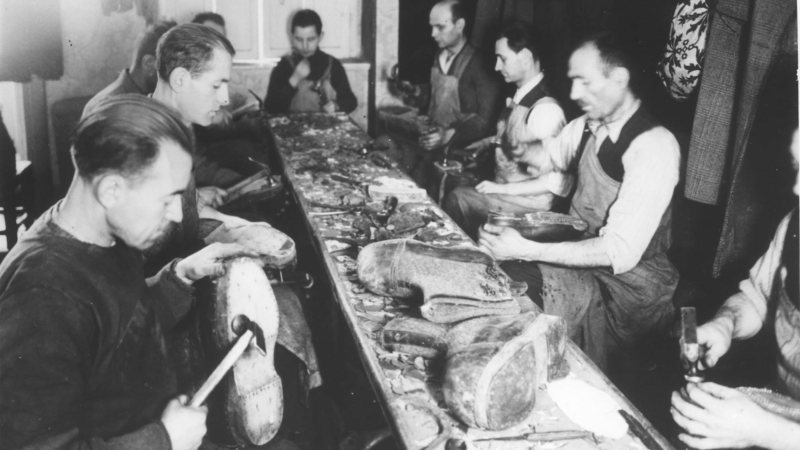Avraham Hendel and the Rebbes’ workshop
One of the managers of the war-time Shultz factory, located in the ghetto area at Nowolipie 44-46, was the former owner Avraham Hendel (1894-1973). He was born in Sokolow Podlaski and was known from his youth as a sharp minded Torah scholar. Hendel, a Chassidic Jew was follower of the (1) Rebbe of Sokolow and lived in Mlawska Street in Warsaw. Before the war he had been a well-known leather wholesaler, referred to as the “king of the leather business”, with a leather tanning and shoemaking factory. With onset of the German occupation and subsequent confiscation of property, a German industrialist from Danzig, Fritz Shultz, took over the business leaving Hendel as the manager of his former factory.
Multiple testimonies and diaries from the ghetto period confirm that Hendel was instrumental in providing refuge for a number of major religious and community leaders who were trapped in the Warsaw ghetto. Eventually, they were deported to Trawniki and ultimately murdered, although Hendel himself escaped from the ghetto to the Aryan side of Warsaw. He participated in the 1944 Warsaw uprising and disguised as a priest, was subsequently sent to the Dachau concentration camp. After the war he emigrated to Israel.
As conditions in the ghetto deteriorated and deportations began, the ghetto population franticly sought employment in the various German run workshops, since those possessing work documents were initially exempt from deportation.
That many orthodox Jews found it difficult to secure a position in the workshops, and on occasion were the target of resentment or disdain by various managers, is confirmed by Miriam Apfelbaum in her book, Two Flags. She states that people crowded together in front of the two entrances to the factory at number 46, in particular orthodox Jews, and that thanks to Avraham Hendel, it was easy for religious Jews to get hired there whereas in other workshops it was “difficult, if not impossible.” (2) The situation for anyone of a more mature age was even more difficult.
Hendel attempted to provide employment, and therefore safety, for the major rabbis and religious leaders left in the ghetto. The elite of Polish rabbinic authority and scholarship gathered in the Shultz workshop under the guise of simple tradesmen and shoemakers. Having no prior experience, they benefited from a variety of ruses and tricks that Hendel conceived to protect them and, that as much as possible, allowed them to maintain their orthodox lifestyle.
Major figures included rabbi Aryeh Zvi Frumer, dean of the Lublin yeshiva, the Piaseczno rebbe, rabbi Klonymous Kalman Shapiro, and the rebbes of Sokolow, Aleksander, Krimolow, Radomsk and Sochaczew.
Other personalities specifically mentioned are rabbi Moshe Betzalel Alter, brother and named successor of the Gerrer rebbe, rabbi Menachem Mendel Alter of Pabianice, the rebbe of Strykow, and the rabbi of Sosnoweic, rabbi Dovid Halberstam.
Hillel Seidman, in his Warsaw Ghetto diaries, records what he experienced during a visit to the shoemaker’s workshop. He writes that when he arrived in the Shultz factory when the workers were praying and reciting the traditional Hoshanos ceremony. He confirms that due to the efforts of Avraham Hendel, the Shultz workshop employed the “cream of orthodoxy”, including chasidic rebbes, rabbis, Torah scholars, and religious activists. At one workbench, officially seemingly repairing shoes was, rabbi Yehuda Aryeh Frumer, formerly Rosh Yeshiva at Chachmei Lublin yeshiva, his lips moving, obviously studying Torah by heart. Sitting opposite was the Piaseczno rebbe, rabbi Klonymous Shapira.
He mentions Avraham Shlomo Rabinowicz, son of the Niestadler rebbe and rabbi Alter the rabbi of Pabianice, rabbi Dovid Halberstam of Sosnowiec, and Blumenfeld an activist from the Mizrachi movement as “workers” in the shoe repair workshop.
According to Seidman, “The Shultz factory is a whole world on its own, providing a sanctuary for religious Jews, where the remaining survivors sit and study. Despite privation, starvation, and fear, they rise above their dismal surroundings and soar to great spiritual heights.” (3)
Reuven Felshuh (Ben-Shem) refers in his diary to the shoemaker’s department of the Shultz workshop. He originally identified the manager, but the name is torn from the surviving copy of the document. He is obviously referring to Avraham Hendel, described as a wealthy and devout chassid, and that due to the efforts of this manager, only orthodox Jews were working there. He describes how Jews (a reference to the various rabbis gathered in the workshop) worked alongside genuine tradesmen. The tradesmen produced the required quota, and the “workers” continued their lives, praying and studying as if nothing had changed.
At midnight, a watch was kept in case of the arrival of the Germans. Everyone prepared for the midnight recitation of Psalms and entreaties to God. At dawn, the morning prayers were said with chanting and great concentration. On Shabbes and Holidays, they participated in the customary three meals and Melava Malka, in accordance with the halacha.
He claims that the Rebbes of Sokolow and Piaseczno, among the last remnants of several hundred rabbis of Warsaw, conducted “Tish” (the traditional Chassidic meal with the Rebbe) and hundreds of chassidim received “shirayim” and forgot about the world, singing and excitedly listened to the Torah of their Rebbes. (4)
Seidman, in the Warsaw Ghetto Diaries, testified that Hendel assisted in rescuing R’ Moshe Betzalel Alter from deportation by personally paying 8000 zloty. (5)
In 1963 Avraham Hendel gave a rare interview which was published in the journal “Beis Yaakov” under the title “The last path of the Torah Giants in the Warsaw ghetto”, giving a first-hand account of events previously unknown.
- See testimony of Yisrael Farber, Yizkor book Aleksandrow Lodzki pg. 233-235 who claims that Hendel was an Alexander chassid.
- Two Flags (pg. 108), Miriam Apfelbaum. Jerusalem; New York: Gefen, 2007.
- Dr Hillel Seidman, The Warsaw Ghetto Diaries Targum Press, 1997. (Entry dated, Hoshana Rabba October 2nd, 1942).
- Diary entry of Chag Sukkos, 1942
- Hillel Seidman, The Warsaw Ghetto Diaries Targum Press, 1997. (Entry August 26th, 1942).


